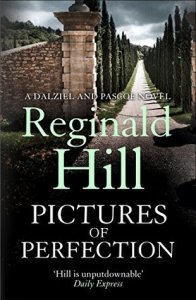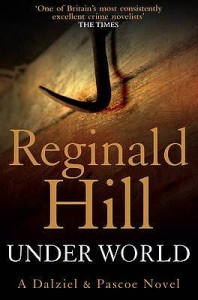
3*s
I debated with myself whether or not, this the first in the superb Dalziel and Pascoe series could or should be included as one of my Classic Club’s crime reads, at the end of the (very) long battle with myself I decided against, but having now read it I think it would have provided an excellent example of what was expected from crime fiction at the start of the 1970s but more of that later in the review.
This police procedural revolves around the local Rugby Club and in a brutal match poor old Sam Connon, ‘Connie’ to his team-mates, gets a boot to the head and retires off the pitch early. After not feeling too well, despite the medicinal alcohol, he gets into his home and drives home. His wife, Mary Connon apparently less than impressed with his late arrival for dinner doesn’t speak to him and Connie duly passes out on his bed. Later the police are called, Mary Connon has had her head bashed in.
Even in this early book the plotting is seamless if the set-up is somewhat less than inspired than in the author’s later books but for all that, he clearly knows the rules and has lined up a selection of suitable and distinct suspects for the pot. Unsurprisingly Dalziel is a member of said rugby club, which is what the plot revolves around. We have a variety of men who almost made it big, those who keep order, their time having passed, and of course those whose attendance is possibly fuelled as much by the attractive young women who provide the decoration as the game. Peter Pascoe is there by dint of his job, i.e. being Dalziel’s whipping boy, the object of his derision as he hasn’t yet been promoted to any sort of sounding board at all and so most of his action is via monologues which always veer back to the attractive ladies. Common with what makes his later books so individually memorable is that the book uses the English language so well, the author using the rugby theme to sprinkle its terms through the book and somehow giving the feeling of something more than any old crime fiction novel. Of course I appreciated the more literary leanings in Pictures of Perfection but fortunately, I live with a man who supports Wales in the rugby, and so many of the terms were at least familiar to me.
And here’s the thing, the book isn’t wonderful but it is better than a great many, but the focus of all the male attention seemingly various beddable women was a bit of a shock to the system! It is hard to read in this day and age and imagine that fiction was created out of fact. Did my parent’s generation really spend their entire lives only interested in certain parts of anatomy? Was it really necessary to have some character or another lusting in various crude ways over one woman or another quite so frequently? Apparently the answer is yes. Welcome to the seventies!
That said, because I am a huge fan of this series it is possible to see that where Dalziel is in this book merely brash and uncouth, he did grow into a man with far more facets to his character and fortunately Peter met Ellie who put a stop to all that desperate lusting over girls far too young for him. And best of all I now know the exact point where the two men first fight crime. The carefully negotiating of the alliances that are so important in the small town Yorkshire setting is where these polar opposites will learn to use their very distinct skills to solve a few more crimes in the future. It isn’t just Dalziel and Pascoe that held my interest though, for all the sexism, even at this stage Reginald Hill has a range of characters that are far from stereotypical for the age with some particularly delightful lines from the bit player Anthony who is Connie’s daughter’s boyfriend. He’s introduced via a particularly squirm inducing scene where despite the death of her mother Connie has a brief consideration is given to whether it is appropriate for the two to share a room, of course it isn’t!
I wouldn’t recommend that anyone starts with this book. My entry to the series was probably over two decades later and read in random order depending on what the library had to offer, and over the last few years I have had enormous pleasure in re-reading a few and really appreciating the depth that this author bought to the genre. A Clubbable Woman might not be up with the best but it most definitely wasn’t without its merits.
A Clubbable Woman is the eighth book I’ve read for my Mount TBR Challenge 2018 having been purchased in November 2017 so I gain another third of a book token!
First Published UK: 1970
Publisher: HarperCollins
No of Pages: 256
Genre: Crime Fiction – Series
Amazon UK
Amazon US
Dalziel & Pascoe Series
A Clubbable Woman (1970)
An Advancement of Learning (1971)
Ruling Passion (1973)
An April Shroud (1975)
A Pinch of Snuff (1978)
A Killing Kindness (1980)
Deadheads (1983)
Exit Lines (1984)
Child’s Play (1987)
Under World (1988)
Bones and Silence (1990)
One Small Step (1990, novella)
Recalled to Life (1992)
Pictures of Perfection (1994)
The Wood Beyond (1995)
On Beulah Height (1998)
Arms and the Women (1999)
Dialogues of the Dead (2002)
Death’s Jest-Book (2003)
Good Morning, Midnight (2004)
The Death of Dalziel (2007)
A Cure for All Diseases (2008)
Midnight Fugue (2009)















